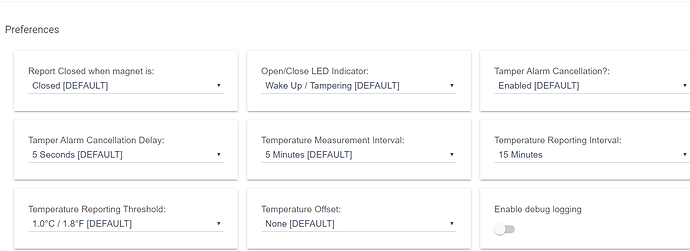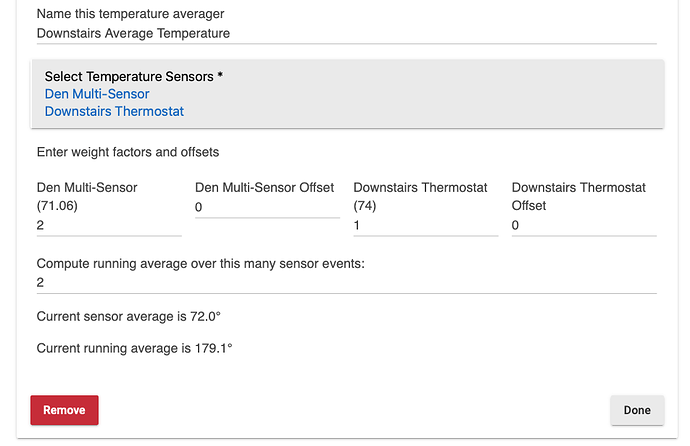No, these would not slow anything down.
Mine sped up.
Any chance we could get a version for "Relative Humidity" too?
Oops, thanks!
Question... why would you prefer this method versus just having the average calculated immediately any time any sensor’s value changes? ![]()
Most sensors send a report on an interval already. Everytime a report comes in from a selected sensor, it updates the average. Thus the options on the sensor device set the interval. Typically settings for rapid change reports and interval reports are offered. Send a report every 5 mins OR If the LUX changes by 20%... that kinda thing. ![]()
They say that full bright sun is >10,000 lux. My Aeon Multisensor6 that is outside facing my front door/walkway is currently "looking" at shade and is reporting 1065 LUX. Luxurant is calculating 8455 LUX due to virtually no cloud cover on a 15 min interval.
In other words shifts of 3 & 10 might just be noise.
I would say these values are from devices such as Zooz 4-1's which Illuminance values are only a calculation of actual Lux readings based down I believe to like a 0-50 scale. If it is from these (I have 4 of them) their readings are terrible for Lux reliability. 2 of mine are in the SAME ROOM about 15 feet apart one says a lux of 2 and the other says a lux of 6.
You could easily be right...
I was thinking that for ME, and my outdoor Aeon Multisensor6, I wouldn't use 3 or 10, because it's too small a fraction of the actual reporting range. (As in: I don't actually care if it's accurate, just repeatable.. will it be 1065'ish tomorrow?) Using 10 would be 10% to me and that's too small for MY use as a 'rapid change' -- I'd get that on the next reporting interval. In other words, if it moved 10% to 1055 or 1075, would that be what I was waiting for to move blinds or add some light in a room. In my case, no. Waiting 5 mins for the next interval would be "good enough."
If 3 & 10 are respectable rapid change values, then great, 
Thanks for this app -- much appreciated.
I've got a feature enhancement suggestion. Instead of a checkbox to select devices, could devices be indicated by a multiplier, defaulting to "1"? This would easily enable a weighted average,.
As a use case, I'm averaging temperature throughout my house, based on water detectors & motion detectors. While the values contributed by the water detectors in the basement are interesting in the overall average, they are less important to me than the value of the temperature in the bedroom. It would be useful to have a weighted average, where "temp under hotwater heater multiplier = 0.5" and "bedroom temp multiplier = 3", and the other 15+ temp sensors throughout the house default to 1, for example.
The UI doesn't work quite that way, but I have updated the repo to allow for weighted averages to be calculated.
Great! Thanks!
Is there a way to do a moving or running average over the last X observations? I've got an outdoor fridge with temp sensors in the garage. When someone opens the door to put something in it, it trips the temp limit I have. What I really need is a running average where the temp is trended and if consistently higher, it trips the limit. As it is now, it's the boy that cried wolf.
Suggestions? I've started looking through bangali's code around Room Manager as I think he has a moving humidity measure (that's what I've read, anyway). Any other suggestions?
You must have that temp limit set really low. On both my fridges the rule machine notification sends me a notification if either of them go above 50 degrees. Normally they stay within the 33-38 degree range. It takes a long time with the door being open for the temp to reach above 50.
45 degrees for fridge and 10 for freezer. I've been avoiding raising it because if it really was a failure, I'd want to address quickly.
It's a creaky side-by-side that continues to perform. I'm just waiting for the day when it fails. Open either door and all the cold just falls out. Temp spikes briefly and then drops back into range within 5 min or so. I've been pushing my wife to let me trade it out for a chest freezer, but she doesn't want to give up the fridge space.
If you're set on using the 45 degrees, then I would recommend using a different sensor that's driver is adjustable on when it takes temperature measurements and reporting. I use the Fibaro FGK-101's that use the native Fibaro Door/Window Sensor 2 driver, this way it would be every 5 minutes it takes a reading which should be more than enough time to recoup the drop from opening the door.
I have updated the app in the public repo to give a running average option. You have to pick how many sensor events you want to include in the running average. If you don't put a number of events in the app uses 1, which is simply the current average of the sensors. The running average is an average of averages.
How many events to choose depends on how sensitive you want this to be. The longer the running average, the less sensitive it is to each temperature event. You need to know the rate at which these events are happening to make that decision.
bravenel - You are a scholar and a gentleman, sir. I want to see how you did this as I could not figure out how to approach this myself. So many thanks!
waynespringer79 - I'm using a NodeMCU board driving 2 AM2302 temp/humidity sensors and two copper tape mechanical contact switches. I can set the sensor polling rate at 1 min per side. I need to think through the right window - to bravenel's point. Basically need enough time to get to local store and get dry ice if something went wrong while I figure out plan B. Like replacing the damned thing...Or hosting the neighborhood for a cookout.




